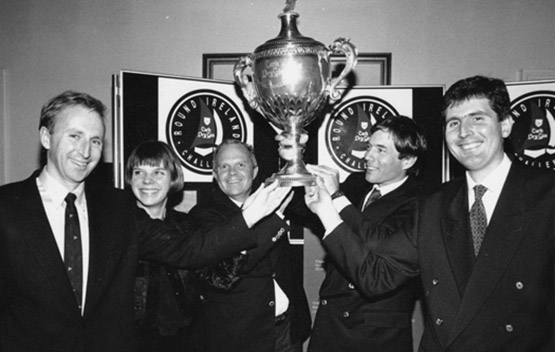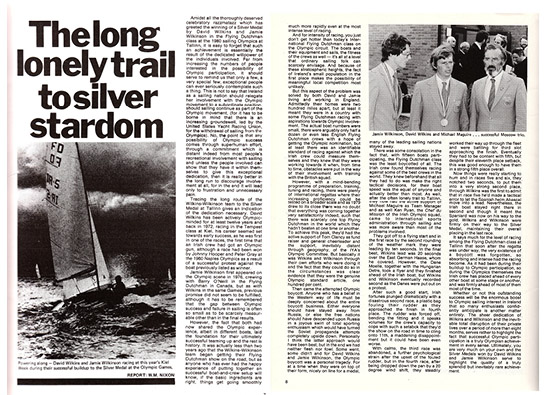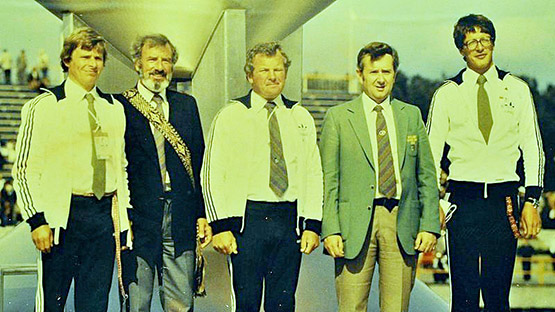With yesterday’s fourth day of sailing for the Women’s Laser Radials at the Rio Olympics bedevilled by light breezes after unusually strong winds earlier in the week, pressure is intensified on Annalise Murphy, who has electrified everyone at home with an inspirational performance. Although she slipped from the lead to third overall after recording an 18th in yesterday’s first race in light conditions, she saw an improvement in the second contest (Race 8) to take 12th and continue in a clearer third place overall. W M Nixon takes a look at the family background which has provided the foundations for this world class sailor, and analyses how our Olympic sailing history has made the hope for a medal almost a national obsession.
Olympic sport is a matter of intensely private effort made under an unprecedented level of global scrutiny. And Olympic sailing can seem like a particularly exquisite form of torture, as it manages to combine the toughest elements of the sprint with the marathon.
The sprint side is obvious. The races of the 2016 Olympiad can seem almost absurdly short to the observer, even if they seem long enough to the participants, particularly those who have carved out a lead. But the insidious marathon side is to be found in the overall length of time the entire series takes up. Days and days. It’s like war. Brief periods of intense excitement and activity, separated by long periods – day after day - of waiting. Boredom could become an enemy for the psychologically unprepared.
In sailing in particular, the complexity is total. This vehicle sport, in which the mysterious wind is the driving power, and on an unpredictable sea at that, is a severe test for athletic ability, technological savvy, tactical and strategical techniques, and the most profound depths of psychological inner strength.
Even in a normal sailing area, that’s how sailing is. But the sailing in Rio is heroically abnormal. In fact, for the first five days of the Sailing Olympiad 2016, it could be argued that the sailing conditions are the unpredictable stars of the show. Offshore breeze with smooth water? Then you can get little bullets of wind curving round those crazy peaks to have one boat planing along while another well within shouting distance is just plodding. Strong onshore winds? They don’t mess about – these are winds, they’re not breezes, and on the most seaward course area at Copacabana, the result can be waves as big as house.
And then yesterday came light airs. So those who are doing well are those who are keeping themselves unfazed by the kaleidoscope of sailing conditions. And as Annalise Murphy has made no less than nine prolonged sailing visits to the race area in the three and more years since she shook off the upset of suddenly dropping out of the medals at the London Games of 2012 in the final Medals Race itself, Rio is almost a home from home, and she knows its wayward ways
But inevitably as she comes within striking distance of a medal in Rio, everything is magnified. But not in any panoramic way. We’re talking microscopic magnification here. Her every move, every facial expression, every statement, is minutely dissected and analysed.
A fortnight ago here, in trying to set the scene, we gave an impression of the team as they prepared to depart for Rio:
“So how are our sailors going to do in Rio? As Annalise Murphy has more experience of the venue than anyone else, her opinions were of special interest. She crisply dismissed any grumblings about the flukiness of the sailing waters by saying that the unpredictability is so general in sailing in Rio’s winter (or what passes for winter when you’re near enough to the equator) that in the end it’s the same for everyone.
Certainly she’s giving it her best shot, and she has benefitted – as have all the Irish sailing squad - from the involvement (intensive in her case) of uber-coach Gary Keegan of the Institute of Sport. He’s leaving the Institute for a new venture after the Olympics, but for now, he has helped guide Murphy to peak form, thanks to a closely-controlled weight reduction programme as part of a carefully-monitored training plan which, at Tuesday’s conference, had the Irish sailor looking extremely fit and well, with her mental outlook in a very good place.”
The Annalise Murphy who went off to the Olympics less than a fortnight ago was a very different person from the frustrated sailor who was disappointed with her own international performances early in the season. There’ll be time enough, once these Olympics are over, to learn about how the transformation was brought about in such a relatively short time. But some hints of the psychological adjustments which have been made came through from various sources.
In her interviews this week, as the mesmerizing saga of her consistency at the top of the Women’s Laser Radial leaderboard has unfolded to capture the national imagination, one of her comments stands out. She has said several times – indeed, many times – that she’s enjoying herself. Ally that with her determination to take it one race at a time, together with her new extra-trim fitness levels, and in all, Ireland has a formidable presence among the pace-setters in her class.
It speaks volumes for her strength of character, which in turn speaks volumes for the family background from which she has emerged. But then, when you have parents like Con Murphy and Cathy McAleavey, the likelihood of your own sailing being something special is very high indeed.
Con and Cathy were pioneers in multi-hull sailing in Ireland, and then Cathy pioneered in another direction by teaming up with Aisling Byrne to race the 470 for Ireland in the 1988 Olympics, the first Olympics with a specifically women’s class.
 Cathy McAleavey and her daughter Annalise Murphy racing the family’s Water Wag in the Volvo Dun Laoghaire Regatta. Photo VDLR
Cathy McAleavey and her daughter Annalise Murphy racing the family’s Water Wag in the Volvo Dun Laoghaire Regatta. Photo VDLR
Cathy has since become a tower of strength in the classic boat movement with new boats for the Water Wag and Shannon One Design classes built with the great Jimmy Furey of Roscommon, but for many years before that she was a serious competitor in the Lasers. Yet it was the Holy Grail of the Round Ireland Sailing Record which really brought Con and Cathy into the limelight way back in 1993, when they persuaded Steve Fossett to bring his 60ft trimaran Lakota to Ireland for a record challenge in September. It was a challenge in which Con and Cathy were key members in the crew, a challenge so perfectly calculated that their record time stood for 22 years.
Thus there was a satisfying completeness to the global sailing scene as it impinged on their home club of the National Yacht Club last night, for not only were members gathered to cheer Annalise on her way as she sailed races 7 and 8 of the Rio Olympics, but American speed sailor Lloyd Thornburg was back in town to embrace the trophy which he so recently won with Phaedo 3’s new Round Ireland record, a trophy which first appeared when the Lakota record was set back in 1993.
 The crew of Lakota in the National Yacht Club after her Round Ireland Record in 1993 are (left to right) Con Murphy, Cathy McAleavey, Steve Fossett, Dave Scully, and Brian Thompson who currently sails with Lloyd Thornburg on Phaedo 3.
The crew of Lakota in the National Yacht Club after her Round Ireland Record in 1993 are (left to right) Con Murphy, Cathy McAleavey, Steve Fossett, Dave Scully, and Brian Thompson who currently sails with Lloyd Thornburg on Phaedo 3.
As for Irish involvement in the sailing Olympics, it goes back only to 1948, as it had taken some time since Irish Independence in 1921 to establish a separate Irish national sailing identity. In fact for some time to come, most contentious sailing matters were still to be referred to the Yacht Racing Association in London, which became the Royal Yachting Association in 1953).
But for the Olympics in 1948, an ad hoc organization called the Irish Yachting Federation was established to be the required national authority. Thereafter, the Irish Dinghy Racing Association (subsequently the Irish Yachting Association, and now the ISA) took over the role, but today in seeing Ireland contemplate medal territory, it’s timely to salute those who sailed for Ireland in the Olympic cause in times past, for as late starters in the Olympic sailing game, we have an extra edge to our medal hunger. And we can also reflect on the huge changes in boat type used.

IRISH OLYMPIC SAILING REPRESENTATION, 1948-2016
1948 - London (Torquay)
Firefly: Jimmy Mooney
Swallow: Alf Delaney, Hugh Allen
Reserve: D St J Sullivan
Management: Billy Mooney, Errol McNally
1952 - Helsinki
Finn: Alf Delany
1956 Melbourne
Finn: J. Somers Payne
1960 Rome
Flying Dutchman: Johnny Hooper, Peter Gray
Dragon: Jimmy Mooney, David Ryder, Robin Benson
Finn Class: J. Somers Payne
Reserve: Neil Hegarty
Management: Clayton Love Jnr, Alf Delaney
Boatman: Jimmy Miller
1964 Tokyo
Dragon: Eddie Kelliher, Harry Maguire, Rob Dalton
Finn: Johnny Hooper
Manager: Leo Flanagan
1968 Mexico City - Sailing in Acapulco
No competitors
1972 Munich - Sailing in Kiel
Tempest: David Wilkins, Sean Whitaker
Dragon: Robin Hennessy, Harry Byrne, Owen Delany
Finn: Kevin McLaverty
Flying Dutchman: Harold Cudmore, Richard O'Shea
Reserves: Curly Morris, Joe McMenamin
Management: Peter Gray, Ken Ryan, Kare Brevik
1976 Montreal - Sailing in Kingston
470: Robert Dix, Peter Dix
Flying Dutchman: Barry O'Neill, Jamie Wilkinson
Tempest: David Wilkins, Derek Jago
Management: Ken Ryan, Jock Smith
1980 Moscow - Sailing in Talinn
SILVER MEDAL
Flying Dutchman: David Wilkins, Jamie Wilkinson
Management: Michael Maguire, Tom Clancy
 The magic moment – Afloat report on 1980’s Silver Medal
The magic moment – Afloat report on 1980’s Silver Medal
1984 Los Angeles
Finn: Bill O'Hara
Management: Mick Wallace
1988 Seoul - Sailing in Pusan
Finn: Bill O'Hara
Flying Dutchman: David Wilkins, Peter Kennedy
470(Women): Cathy MacAleavy, Aisling Byrne
Reserves: Maeve McNally, Conrad Simpson
Management: Michael Wallace, Con Murphy
1992 Barcelona
Europe: Denise Lyttle
Flying Dutchman: David Wilkins, Peter Kennedy
Star: Mark Mansfield, Tom McWilliam
Reserves: Denis E O'Sullivan, Conrad Simpson
Management: Michael Wallace, Mark Lyttle, Trevor Millar
1996 Atlanta - Sailing in Savannah
Laser - Mark Lyttle
Europe - Aisling Bowman(Byrne)
Finn - John Driscoll
Star - Mark Mansfield & David Burrows
470 (Women) - Denise Lyttle & Louise Cole
Soling - Marshall King, Dan O'Grady & Garrett Connolly
Management - Derek Jago, Paddy Boyd, Anne Blaney and Bill O'Hara
2000 Sydney
Europe - Maria Coleman
Finn - David Burrows
Star - Mark Mansfield & David O'Brien
Management - Bill O'Hara, James Hynes, Garrett Connolly, Paddy Boyd, Anne Blaney
2004 Athens
Europe - Maria Coleman
Finn - David Burrows
Star - Mark Mansfield & Killian Collins
49er - Tom Fitzpatrick & Fraser Brown
470 - Gerald Owens & Ross Killian
Laser - Rory Fitzpatrick
Management - Garrett Connolly
2008 Qingdao
Star - Peter O'Leary & Stephen Milne
Finn - Tim Goodbody
Laser Radial - Ciara Peelo
470 - Gerald Owens & Phil Lawton
Management - James O'Callaghan
2012 London sailing at Portland/Weymouth
Star - Peter O'Leary & David Burrows
Laser Radial - Annalise Murphy
49er - Ryan Seaton & Matt McGovern
Laser - James Espey
470 - Ger Owens & Scott Flanigan
2016 Rio de Janeiro
Laser Radial – Annalise Murphy
49er – Ryan Seaton & Matt McGovern
Laser – Finn Lynch
49erFX – Andrea Brewster & Saskia Tidey
The International Star was the unlikely provider of the last gasp for keelboats, and that was in the 2012 Olympics. Although the Stars still harbour hopes that they will get a call to return to the five ring circus, no-one else sees keelboats happening again in the line–up, as the athletic approach to sailing takes over completely.
As it is, involvement with the Olympics can knock a class off course completely, and over the 120 years of Olympic sailing, only a few of the boat types involved longterm have emerged unscathed. All of which resonates to the great credit of the Bruce Kirby-designed Laser. Here at last is a boat which can be both a very viable Olympic class – it has the biggest fleet at Rio – while also being a boat which succeeds for sailors at all levels. So let’s hear it for the gallant little Laser – she has risen above the Curse of the Olympics.
Meanwhile out in Rio yesterday the evening trickled away and still the quest for another medal, the first since 1980, goes on. Over the years, the level of Irish achievement has gradually risen. In 1960 when the Rome Olympics staged the sailing in Naples, we had our first race win by Peter Gray and Johnny Hooper, but that was by default as the Italian crew were disqualified after it was proven they’d left out a mark.
Thus it was 1972 at Kiel in Germany before Ireland got a race-winning gun, for David Wilkins and Sean Whitaker in the Tempest two-man keelboat. And then eight years later it was David Wilkins – our most tenacious Olympic sailor – who finally brought home the Silver Medal, crewed by Jamie Wilkinson in the Flying Dutchman, a two-man 20ft dinghy which seemed the height of modernity at the time, hut with a massively over-lapping genoa which went round the block and back again, she now seems almost quaint.
 The team which took the Silver Medal in 1980 are (left to right) David Wilkins (helm), Michael Maguire (Manager), Kare Brevik (Meteorologist), Ken Ryan (Chef d’Equipe) and Jamie Wilkinson (crew)
The team which took the Silver Medal in 1980 are (left to right) David Wilkins (helm), Michael Maguire (Manager), Kare Brevik (Meteorologist), Ken Ryan (Chef d’Equipe) and Jamie Wilkinson (crew)
But yesterday’s conditions weren’t quaint. They were maddening. Racing went nowhere at first, but by the second race - Race 8 - a reasonable breeze filled in further offshore. Annalise Murphy’s 18th in Race 7 should be seen in the broader context, with Race 8’s 12th firming up her third overall. For Olympic newbie Finn Lynch in the Men’s Laser the competition piled on, and he had to be content with a 33rd in Race 7 which tested his resolve, as it puts him back to 28th overall in a series in which he was showing in the top third of the 46–strong fleet in the early races, but her finished the day 30th overall.
As for the next wave of classes now coming into their programmes, Matt McGovern and Ryan Seaton in the 49er were best, they showed a 14th for the first race, but an outstanding second in Race 2 shunted them up to fifth overall, which is definitely something to work with.
But taking the long view, a medal is a medal. After 36 years, the people are hungry and thirsty. So for now, here’s to the Flying Dutchman, which did it for us back in 1980.
The International Flying Dutchman. All of 20ft long, and with a genoa only for heroes. But she brought home the Silver for Ireland in 1980
































































